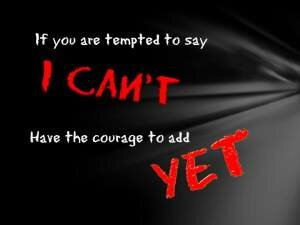 |
| Michael Jordan quote [Image]. (2013). Retrieved from https://www.pinterest.com/pin/253257179017778195/ |
The power of believing that you can improve [Video]. (2014). Retrieved from https://www.ted.com/talks/carol_dweck_the_power_of_believing_that_you_can_improve?language=en
Teaching about mindset is especially important as scientific evidence
demonstrates that an emphasis on intellect or talent leaves students fearful of
challenges and making mistakes (Dweck, 2007). Children who were praised
for their intelligence solved significantly fewer problems after a failure than
those children who were praised for their efforts, as demonstrated in this
image (Dweck, 2007).
 |
| Mindset 2012 NIU advising summit [Image]. (2013). Retrieved from http://www.slideshare.net/StevenEstes/mindset-2012-niu-advising-summit |
When it comes to assessment, it is important that
teachers discuss within their feedback both the students’ competencies and their areas
for improvement (Drake et al., 2014). I know that in my experience as a
student, I always liked getting feedback that told me what I did well and what
I needed to do to improve so that I had something to strive for on my next
assessment. This table shows what teachers can do and how they can assess
students so they facilitate the development of a growth mindset.
 |
| McMillan, Helsten, & Klinger [Image]. (2010). Retrieved from Drake, Reid, & Kolohon (2014). |
Additionally, students perform better in school when they and their teachers
believe that intelligence is not fixed, but can be developed (Dweck, 2010). In
a study of 100 students in New York transitioning into grade 7, students’
mindsets were measured at the beginning of the school year. It was found that
students with a growth mindset outperformed their peers who had fixed mindsets
(Dweck, 2010). As a teacher candidate, I recognize the importance of teaching
students about a growth mindset as “it relates to the presence of failure and
perseverance” (Dweck, 2006) within the classroom. I have been lucky to have the
opportunity to observe some of the practical ways that educators incorporate teaching
about mindset into their programs. My mom, who is a primary teacher, began introducing
the topic of growth mindset by having her students build a house of cards.
 |
| Growth mindset [Photograph]. (2015). Retrieved from https://twitter.com/CNFKenollie/status/595252773236699136 |
This activity started a conversation about perseverance and
grit. By challenging the students with a difficult task, they had to problem solve
and think about different strategies to use so that they could be successful.
Another way to teach about mindset and differentiate between a growth mindset
and a fixed mindset is to create a list of statements and questions that reflect
what each mindset would sound like in a classroom setting (Dweck, 2006).
 |
| Sorting mindset statements [Photograph]. (2014). Retrieved from https://twitter.com/CNFKenollie/status/537709823203475458 |
Finally, teaching students about “The Power of Yet” is an
amazing way to get them to develop a growth mindset so that they believe that
their lives are filled with endless possibilities.
Sesame street: Janelle Monae - Power of yet [Video]. (2014). Retrieved from https://www.youtube.com/watch?v=XLeUvZvuvAs
I
particularly like this video as it teaches students through song and makes the
topic relevant to their lives so that they can better understand the word “yet”.
 |
| The power of yet [Photograph]. (2015). Retrieved from https://twitter.com/CNFKenollie/status/644586155611176960 |
Recently, my mom created this board with her grade one
students about things that they can do and things that they “can’t do…yet” to
teach them about the power of “yet” by using examples from their lives.
Additionally, the math game “Brain Points,” developed by Carol Dweck and her colleagues,
rewards “yet” by giving rewards for effort, strategy, and progress rather than
when students get the right answer (Dweck, 2014). This game is a brilliant way
for students to use perseverance and problem solving strategies within the
classroom.
I
will conclude this blog on teaching students in a primary classroom about
growth mindset by stating that, as educators, we need to teach children to
understand the power of “yet” and know how to dream big dreams. We must create
a time where children live in a world FILLED with “YET”.
 |
| The power of yet [Image]. (2014). Retrieved from http://webenglish.se/power-yet/ |
References
Drake, S. M., Reid,
J. L., & Kolohon, W. (2014). Interweaving
Curriculum and Classroom Assessment:
Engaging the 21st Century
Learner. Don Mills, ON: Oxford University Press.
Dweck, C. (2006). Mindset:
The new psychology of success. Random
House.
Dweck, C. S. (2007).
The secret to raising smart kids. Scientific American Mind, 18(6), 36-43.
Dweck, C. S. (2010).
Mind-sets. Principal Leadership, 10(5), 26-29.
Dweck, C. S. (2014,
November). Carol Dweck: The power of believing you can improve [Video file]. Retrieved from
https://www.ted.com/talks/carol_dweck_the_power_of_believing_that_you_can_improve?language=en
Growth mindset
[Photograph]. (2015). Retrieved from https://twitter.com/CNFKenollie/status/595252773236699136
McMillan,
Helsten, & Klinger [Image]. (2010). Retrieved from Drake, Reid, &
Kolohon (2014).
Michael Jordan quote
[Image]. (2013). Retrieved from https://www.pinterest.com/pin/253257179017778195/
Mindset 2012 NIU
advising summit [Image]. (2013). Retrieved from http://www.slideshare.net/StevenEstes/mindset-2012-niu-advising-summit
The power of yet
[Image]. (2014). Retrieved from http://webenglish.se/power-yet/
The power of yet
[Photograph]. (2015). Retrieved
from https://twitter.com/CNFKenollie/status/644586155611176960
Sesame Street [Sesame
Street]. (2014, September 10). Sesame
Street: Janelle Monae – Power of yet [Video
file]. Retrieved from https://www.youtube.com/watch?v=XLeUvZvuvAs
Sorting mindset statements [Photograph]. (2014).
Retrieved from https://twitter.com/CNFKenollie/status/537709823203475458
